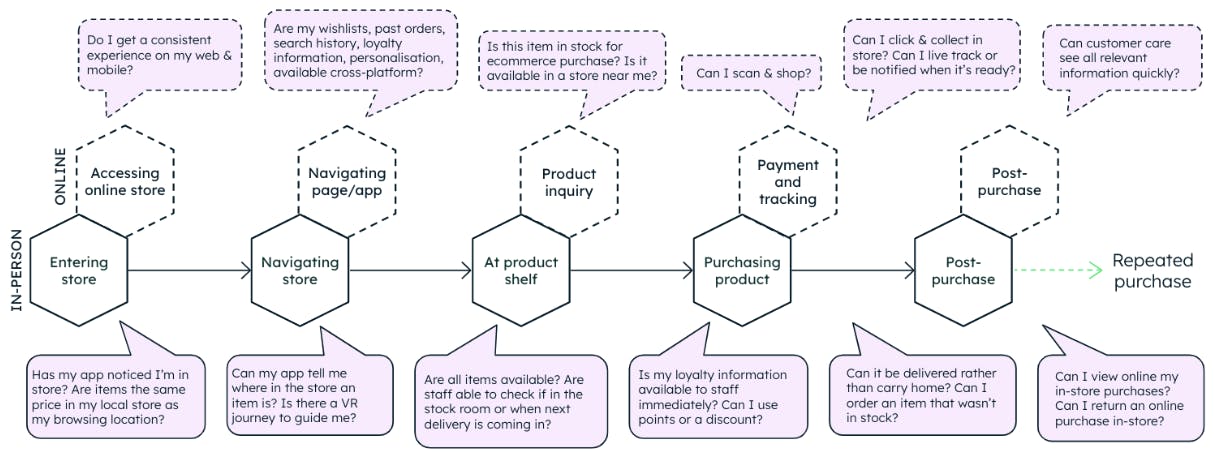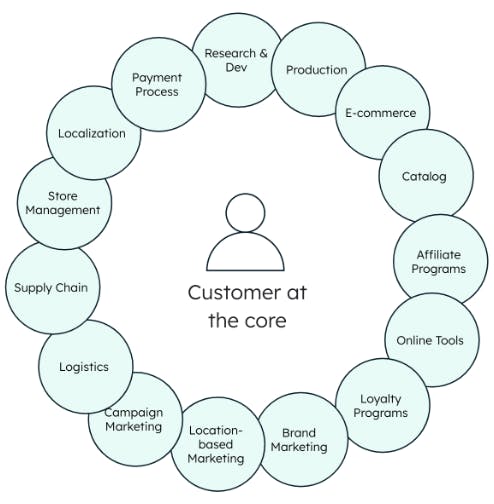Break Down Silos with a Data Mesh Approach to Omnichannel Retail
Omnichannel experiences are increasingly important for customers, yet still hard for many retailers to deliver. In this article, we’ll cover an approach to unlock data from legacy silos and make it easy to operate across the enterprise — perfect for implementing an omnichannel strategy.
Establishing an omnichannel retail strategy
An omnichannel strategy connects multiple, siloed sales channels (web, app, store, phone, etc.) into one cohesive and consistent experience. This strategy allows customers to purchase through multiple channels with a consistent experience (Figure 1).
Most established retailers started with a single point of sale or “channel” — the first store — then moved to multiple stores and introduced new channels like ecommerce, mobile, and B2B. Omnichannel is the next wave in this journey, offering customers the ability to start a journey on one channel and end it on another.

Why are retailers taking this approach? In a super-competitive industry, an omnichannel approach lets retailers maximize great customer experience, with a subsequent effect on spend and retention. Looking at recent stats, Omnisend found that purchase frequency is 250% higher on omnichannel, and Harvard Business Review’s research saw omnichannel customers spend 10% more online and 4% more in-store.
Omnichannel: What's the challenge?
So, if all retailers want to provide these capabilities to their customers, why aren’t they? The answer lies in the complex, siloed data architectures that underpin their application architecture. Established retailers who have built up their business over time traditionally incorporated multiple off-the-shelf products (e.g., ERP, PIMS, CMS, etc.) running on legacy data technologies into their stack (mainframe, RDBMS, file-based). With this approach, each category of data is stored in a different technology, platform, and rigid format — making it impossible to combine this data to serve omnichannel use cases (e.g., in-store stock + ecommerce to offer same-day click and collect). See Figure 2.

The next challenge is the separation of operational and historical data — older data is moved to archives, data lakes, or warehouses. Perhaps you can see today’s stock in real time, but you can’t compare it to stock on the same day last year because that is held in a different system. Any business comparison occurs after the fact.
To meet the varied volume and variety of requests, retailers must extract, transform, and load (ETL) data into different databases, creating a complex disjointed web of duplicated data.
Figure 3 shows a typical retailer architecture: A document database for key-value lookup, cache added for speed, wide column storage for analytics, graph databases to look up three degrees of separation, time series to track changes over time, etc.

The problem is that ETL’d data becomes stale as it moves between technologies, lagging behind real-time and losing context. This sprawl of technology is complex to manage and difficult to develop against — inhibiting retailers from moving quickly and adapting to new requirements. If retailers want to create experiences that can be used by consumers in real-time — operational or analytical — this architecture does not give them what they need. Additionally, if they want to use AI or machine learning models, they need access to current behavior for accuracy.
Thus, the obstacle to delivering omnichannel experiences is a data problem that requires a data solution. Let's look at a smart approach to fixing it.
Modern retailers are taking a data mesh approach
Retail architectures have gone through many iterations, starting from vendor solutions per use case, moving toward a microservices approach, and landing into domain-driven design (Figure 4).
| Vendor Applications | Microservices | Domain-Driven Design |
|---|---|---|
| * Each vendor decides the framework and governance of the data layer. The enterprise has no control over app or data | * Microservices pull data from the API layer | * Microservices and core datasets are combined into bounded contexts by business function |
| * Data is not interoperable between components | * DevOps teams control their microservices, but data is managed by a centralized enterprise team | * DevOps teams control microservices AND data |